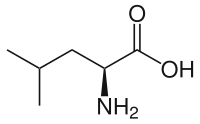
Photo from wikipedia
Eukaryotic cells monitor and regulate metabolism through the atypical protein kinase target of rapamycin (TOR) regulatory hub. TOR is activated by amino acids in animals and fungi through molecular signaling… Click to show full abstract
Eukaryotic cells monitor and regulate metabolism through the atypical protein kinase target of rapamycin (TOR) regulatory hub. TOR is activated by amino acids in animals and fungi through molecular signaling pathways that have been extensively defined in the past ten years. Very recently, several studies revealed that TOR is also acutely responsive to amino acid metabolism in plants, but the mechanisms of amino acid sensing are not yet established. In this review, we summarize these discoveries, emphasizing the diversity of amino acid sensors in human cells and highlighting pathways that are indirectly sensitive to amino acids, i.e., how TOR monitors changes in amino acid availability without a bona fide amino acid sensor. We then discuss the relevance of these model discoveries to plant biology. As plants can synthesize all proteinogenic amino acids from inorganic precursors, we focus on the possibility that TOR senses both organic metabolites and inorganic nutrients. We conclude that an evolutionary perspective on nutrient sensing by TOR benefits both agricultural and biomedical science, contributing to ongoing efforts to generate crops for a sustainable agricultural future.
Journal Title: Biomolecules
Year Published: 2022
Link to full text (if available)
Share on Social Media: Sign Up to like & get
recommendations!